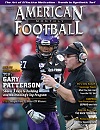AMERICAN FOOTBALL MONTHLY THE #1 RESOURCE FOR FOOTBALL COACHES
Article CategoriesAFM Magazine
|
Expand the Field with Compressed Formationsby: Steve HeckWide Receivers Coach • Kutztown University © More from this issue With today’s defensive players becoming faster and more athletic, the playing field seems to almost shrink a bit each season. Yards, feet, first downs and points are harder to produce. With offenses trending toward spreading people out, another equally effective way to create space is to condense formations with minus splits. Condensed formations expand the field horizontally by manipulating defenders and maximizing the field space from the numbers to the sideline.
|
|
|||||||
| HOME |
MAGAZINE |
SUBSCRIBE | ONLINE COLUMNISTS | COACHING VIDEOS |
Copyright 2026, AmericanFootballMonthly.com
All Rights Reserved



 The full article can only be seen by subscribers.
The full article can only be seen by subscribers.


